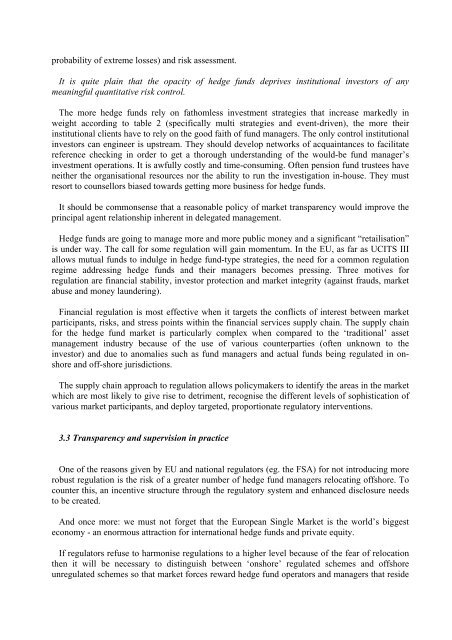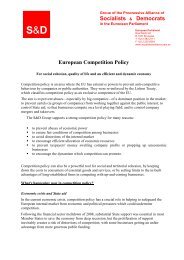Executive summary - Udo Bullmann
Executive summary - Udo Bullmann
Executive summary - Udo Bullmann
- No tags were found...
You also want an ePaper? Increase the reach of your titles
YUMPU automatically turns print PDFs into web optimized ePapers that Google loves.
probability of extreme losses) and risk assessment.It is quite plain that the opacity of hedge funds deprives institutional investors of anymeaningful quantitative risk control.The more hedge funds rely on fathomless investment strategies that increase markedly inweight according to table 2 (specifically multi strategies and event-driven), the more theirinstitutional clients have to rely on the good faith of fund managers. The only control institutionalinvestors can engineer is upstream. They should develop networks of acquaintances to facilitatereference checking in order to get a thorough understanding of the would-be fund manager’sinvestment operations. It is awfully costly and time-consuming. Often pension fund trustees haveneither the organisational resources nor the ability to run the investigation in-house. They mustresort to counsellors biased towards getting more business for hedge funds.It should be commonsense that a reasonable policy of market transparency would improve theprincipal agent relationship inherent in delegated management.Hedge funds are going to manage more and more public money and a significant “retailisation”is under way. The call for some regulation will gain momentum. In the EU, as far as UCITS IIIallows mutual funds to indulge in hedge fund-type strategies, the need for a common regulationregime addressing hedge funds and their managers becomes pressing. Three motives forregulation are financial stability, investor protection and market integrity (against frauds, marketabuse and money laundering).Financial regulation is most effective when it targets the conflicts of interest between marketparticipants, risks, and stress points within the financial services supply chain. The supply chainfor the hedge fund market is particularly complex when compared to the ‘traditional’ assetmanagement industry because of the use of various counterparties (often unknown to theinvestor) and due to anomalies such as fund managers and actual funds being regulated in onshoreand off-shore jurisdictions.The supply chain approach to regulation allows policymakers to identify the areas in the marketwhich are most likely to give rise to detriment, recognise the different levels of sophistication ofvarious market participants, and deploy targeted, proportionate regulatory interventions.3.3 Transparency and supervision in practiceOne of the reasons given by EU and national regulators (eg. the FSA) for not introducing morerobust regulation is the risk of a greater number of hedge fund managers relocating offshore. Tocounter this, an incentive structure through the regulatory system and enhanced disclosure needsto be created.And once more: we must not forget that the European Single Market is the world’s biggesteconomy - an enormous attraction for international hedge funds and private equity.If regulators refuse to harmonise regulations to a higher level because of the fear of relocationthen it will be necessary to distinguish between ‘onshore’ regulated schemes and offshoreunregulated schemes so that market forces reward hedge fund operators and managers that reside





